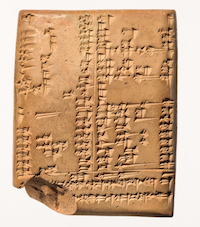|
3,800-year-old Cuneiform Tablet Found in Turkey Quake Rubble
August 14, 2023
One of the finds among the rubble stemming from a devastating earthquake in Turkey earlier this year is a clay tablet that still features cuneiform writing from nearly 4,000 years ago. The February 6 earthquake registered 7.8 on the Richter scale and was felt as far away as Egypt. The death toll in Turkey and neighboring Syria has been estimated at nearly 60,000. Archaeologists digging in the southern province of Hatay have unearthed a small undamaged tablet that they estimated to be 3,800 years old. The writing is the script from ancient Sumeria, one of Earth's first civilizations. Successor peoples imported and adapted that script into their own languages; chief among those languages were Akkadian, Elamite, Hittite, and Hattic. Among the writing on the tablet is a transaction for a king to buy a city. That leader, Yarim-Lim, is the first known king of Alalakh, an Amorite settlement founded in the 3rd Century B.C. and at one time the capital of a city-state named Mukis. The tablet also contains the names of people who witnessed the sale. Archaeological digs began at the site only in the early 20th Century. Since then, many such tablets have been found, along with other hallmarks of civilization such as palaces, temples, houses, and walls. The most recent one was the first to mention Yarim-Lim, in his time a powerful leader and founder of a dynasty that lasted nearly four centuries. |
Social Studies for Kids |
Social Studies for Kids
copyright 2002–2024
David White





